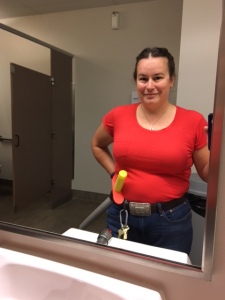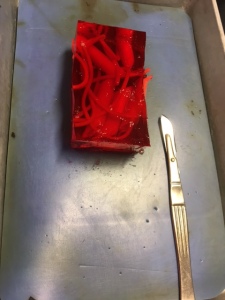
The start of the new term is always exciting, and on the quarter system, we typically begin spring term in late March. The first week of classes is a great time to set the tone of the class and to get student buy in to the way we teach, though it’s never too late to engage our students. In the past ten years of teaching at a small community college, I have slowly progressed away from the traditional lecture to classroom experiences that I hope will engage and clarify. You might call me a partial “flip” as I try to add new active learning strategies to the classroom, many ideas farmed shamelessly from the annual National HAPS conference. Because it is early in the term, I want to make an impression on the students that A&P is different; unlike any class you have taken before.
As engaging as I think my class is, I still fight for attention from my students as their electronics, devices, and lives draw their minds to other things. While the students wait for my class to start, they are often on their phones, and a few review their notes, but rarely is there engagement and most are not getting into the “A&P State of Mind.” I was reading an article in document our state educational board OEA sends out and found an interesting tidbit about getting your student’s head in the game and it stimulated me to come up with something to catch their attention every day. Something that puzzles or challenges them and starts them thinking on our subject.

So I showed up with a sword in my belt (it was foam, not a real weapon). I didn’t say a word and went about my business. Eventually someone asked. Many had wondered. As it was the first week, I have been trying to get them into the habit of asking questions, and it took a few times of asking “Does anyone have a question,” before a student took the bait. “Great question, I’ll show you in a minute.” I used the sword to demonstrate cuts along the planes of the body. Then the students were on their feet and imitating the cuts as I called them out. We added speed, a little laughter, and had an effective lesson.
This has become my challenge: Can I get my students to wonder how today’s prop, picture, or activity relates to the material? Some days are easy. Just today I showed up with envelopes holding index cards with some of the important terms for the day on them. We played a modified game of Taboo. One student put the card up to their forehead. The other students then had to describe the word without saying what it started with, or too much nonsensical rhyming. It was challenging to all students in the group. They had to remember something about the word. My students got into groups as they came into class and played this while other students were arriving. They were using their before class time to interact, review, laugh and they were thinking about the material for the day. Mission accomplished!

I have also shown up to class with a cube of jello with noodles in it on a dissection tray- I posted a picture of this to our LMS the night before just to pique their curiosity. One time I brought in a snazzy little raccoon (our school mascot and a soft object) that was passed around the room. The initial student had to answer a review question. When that student finished their answer, the new student with the raccoon had to answer the next question. “What are the 4 types of tissues?” “What is matrix?”
Next week I’ll have three legos I sneak away from my children: three legos will be sitting at the front of the room (or maybe on each table)- one short and flat, one nice and square, and one tall and skinny. I bet at least a few immediately start wondering how this is related to A&P. Do you know?
I am going to guess epithelial cell types: squamous, cuboidal, and columnar.
I like the idea, even if that’s the wrong guess.